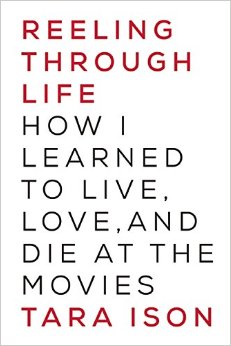Interview: Tara Ison
 Midwestern Gothic staffer Hannah Bates talked with author Tara Ison about being an author and a screenwriter, blending autobiographical elements into her work, who inspires her, and more.
Midwestern Gothic staffer Hannah Bates talked with author Tara Ison about being an author and a screenwriter, blending autobiographical elements into her work, who inspires her, and more.
**
Hannah Bates: What’s your connection to the Midwest?
Tara Ison: The summer I was seventeen, a friend and I drove cross-country, the first time I’d ever been outside California – what a revelation! I couldn’t believe the expanse of all that vast, open land. But what hit me the most was the weather. Rain in summer? It made no sense to me. For me, rain meant Los Angeles winter, which is a flat, chilly gray. Warm rain was surreal. Warm, pillowy grayness was surreal. The thunder and lightning were surreal. I’ve driven cross-country three or four more times since then, and each time I’m still fascinated by the shift in the air – I always feel so unsettled. Unnerved. Definitely a “Gothic” feeling!
HB: You’ve taught creative writing and screenwriting at many different colleges and universities in nearly every region of the country, including three from the Midwest. How has your time in the Midwest influenced your writing?
TI: Yes, I’ve been fortunate to teach at Ohio State University, when I was a Fellow at the Thurber House, and Northwestern University, and Washington University in St. Louis – all the “Midwest,” but they were still so different from each other. I spent only a fall semester in Ohio, but that was my introduction to Autumn with a capital A – my first time to live among changing leaves, and the texture of that was amazing. Northwestern had the sense of nearby ocean I was used to in LA, where you’re always sort of aware it’s there (although Lake Michigan doesn’t have the salt tang), but the big-city bustle of Chicago took me aback. And St. Louis, again, had this very gray but blistering heat, unlike anything I’d ever experienced – it seems to be the weather that always disorients or unsettles me the most.
I think anytime you move to a new place and open yourself up to the sensual differences in the environment and your awareness of a world outside the familiar, you have an opportunity to channel that back into your work, and I’ve tried several times to capture that feeling of disorientation. I’ve set two stories specifically in the Midwest – “Needles,” which is about yet another cross-country drive I took, and “Fish,” inspired by a visit to the koi pond at the St. Louis Botanical Garden (both stories will be in my forthcoming collection.) And the one poem I’ve ever published was also about a drive cross-country, trying to outdrive tornadoes, and the “unstable air” and “blackening red sky.”
HB: Your recent collection of essays, Reeling Through Life: How I Learned to Live, Love, and Die at the Movies, touches on how cinema can affect a person’s identity by allowing them to see other realities. Do you think writing falls short in this respect? Why use a collection of essays to articulate the impact of film as an art form?
TI: I do feel film can offer a slightly more visceral experience than literature – it skips over one level of processing information (the interpretation of language) and goes for an almost pre-verbal absorption of experience. (I can’t help but think of the difference in how we metabolize different drugs/chemicals – smoking vs. oral ingestion vs. injection, to use a slightly creepy example…)
I felt the essay was the best form for what I was trying to explore/capture, which was, as you say, how cinema can affect aspects of identity, and get under our skins in such a powerful way – I needed to blend some objective, critical analysis with the recreation of my immediate emotional and/or subconscious experience watching these films, and create the synthesis of both. The personal essay form allowed for that, which is why I love reading them, and enjoy writing them – the best essays work as inquiry on multiple levels, both intellectual and experiential.
 HB: How did you manage to blend the autobiographical elements with film analysis in Reeling Through Life?
HB: How did you manage to blend the autobiographical elements with film analysis in Reeling Through Life?
TI: It started out a bit technically. First I made lists of films, or mere moments from films, that have stayed with me over the course of my life – sometimes it’s the narrative arc of the character, sometimes just a single image or a line of dialogue, etc. Then I listed the most meaningful or memorable moments/experiences of my life, and I looked for nexus between the two lists, the points of connection where I could see the direct impact of film on my expectations, my hopes, my understanding of how life works.
A good example would be in “How To Lose Your Virginity” – in my mid- to late teens I was extremely aware of the “loss of virginity” scenes from Fast Times at Ridgemont High and Little Darlings, and that directly affected my behavior. (I waited until I was twenty years old!) Some films had a more subconscious influence – such as how I expected death to look (Love Story, Harold and Maude, Dark Victory), and the subsequent shock of watching my grandmother die – I didn’t understand the disconnect in the moment, but I see it now, how film fantasies of death had ill-prepared me for a harsh reality.
There are many films I adore or are very memorable to me that didn’t have such a strong direct or subconscious effect, so I left those out; similarly, there are significant moments of my life where I didn’t see the link back to film, so I didn’t include those autobiographical details in the book. I only wanted to explore the clear relationship between “film lessons” and “life lessons,” and that helped me focus the essays, and structure the overall book.
HB: Are there any “Midwestern” movies that have impacted your life?
TI: I’ll go back to high school, to start with my English teacher showing us The Grapes of Wrath – Henry Fonda and Jane Darwell’s faces are so powerful and haunting, so unforgettable. And then Paper Moon, for the extraordinary depiction of a little girl I’d never seen in film before or since. I’ll add The Last Picture Show, too – perhaps not technically the Midwest (how exactly is that defined…?), but also very powerful, especially in its study of human longing and missed connection. And all three are in black-and-white! That must have something to do with their power, the starkness and nakedness of those images.
HB: What is it like to be both an author and a screenwriter? What modifications are necessary when writing for the screen, as opposed to the page?
TI: It was a hard transition for me – basically, a screenplay is a story told in images, whereas fiction is told in language – and the words on the page have come to fruition, that’s all they need do. It’s the main reason why I’m no longer a screenwriter – I much prefer playing with language!
I discuss this in the “How to be a Writer” essay, when I was struggling to learn about screenwriting (as opposed to writing fiction):
“…I had to learn the screenwriter’s rules: you force your fine prose into screenplay format (which as a form is more rigid and less organic than a sestina); you don’t overwrite description (i.e, leave a lot of white space so the exhausted, overworked reader doing coverage can make it a quick read); you only write what the camera sees, capture the externals, reduce human existence to slug lines (INT. JACK’S BEDROOM – DAY, EXT. MEXICAN RESTAURANT – NIGHT) and make sure characters speak with an eye toward their dialogue margins on the page.
And a screenplay, as a piece of writing, isn’t a finished thing – a screenplay is only a phase of a story, on its way to becoming its realized existence: a movie. So by definition, it isn’t Art; it’s one embryonic part in the construction of Art, the crude charcoal sketch, the stumbling choreography, the sculpture’s wire armature, the mere tinkering with melodic notes. A screenplay is something the screenwriter creates and nurtures and possesses, briefly, then sends on its way. For other people to turn into whatever kind of thing they want. You wave bye bye from the door and hope it isn’t run over by a bus.”
HB: Your novel Rockaway was featured as one of the “Best Books of Summer” in O, The Oprah Magazine, in 2013. In the novel, you balance lyrical prose with colloquial dialogue. Why was it important to you that conversations remained as realistic as possible?
TI: What a great observation, thank you! I did want Sarah’s inner life to be sort of lyrical, almost impressionistically “visual,” because she’s a painter and views experience through a painter’s eye, rather than depicting her thoughts as direct discourse, or an “inner-monologue,” which would more reliant on colloquial-sounding language. So to balance that out, I aimed for other details to be as concrete as possible, including the dialogue, so I might ground the reader in a clearer, more relatable reality. I felt the voice, or style, or lyricism (as you suggest, thank you!) of her introspection would be a bit too much for an entire novel.
HB: Which writers are you most inspired by?
TI: Jeanette Winterson. Andrea Barrett. AM Homes. Denis Johnson. Jim Shepard. Margaret Atwood. Michael Cunningham. Toni Morrison. Nabokov. Alice Munro. Flannery O’Connor. OK, that’s my brainstorm list in this moment. An hour from now I’d come up with a completely different list. And so it goes…
HB: What’s next for you?
TI: Getting ready for the new book coming out in November, the short story collection called Ball. After that, I have no idea…perhaps back to one of the several barely-begun projects I’ve put away over the years, or I’ll start something entirely new! I’ll see what’s in the air….
**
Tara Ison is the author of the novels The List (Scribner), A Child out of Alcatraz (Faber & Faber, Inc.), a Finalist for the Los Angeles Times Book Prize, and Rockaway (Counterpoint/Soft Skull Press), featured as one of the “Best Books of Summer” in O, The Oprah Magazine, July 2013. Her essay collection, Reeling Through Life: How I Learned to Live, Love, and Die at the Movies, was published in January 2015, and Ball, a short story collection, is forthcoming in November 2015, both from Counterpoint/Soft Skull Press.






